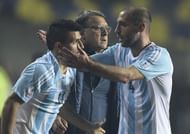Gonzalo Higuain’s penchant for bottling at crucial moments is well-known. The Argentine forward famously missed a sitter against Germany in the World Cup final last year and his penalty howler against Chile was reminiscent of the one he took against Lazio with Napoli. That match, too, had been of some importance - the winner would qualify for the Champions League. Higuain looked a picture of concentration, and then blasted over.
While these wasteful habits of ‘El Pipita’ are lamentable, sometimes downright frustrating, are they nearly enough to be responsible for a team’s failings? Is it fair to Higuain, and indeed to the rest of the team, that a striker who came on as a substitute in the 71st minute of the game is blamed for their shortcomings?
Problems in Attack
Argentina have arguably the strongest forward line in the world on paper, yet their incoordination on the pitch is striking. The signs were apparent from the 5th minute of the Copa America final itself, when Lionel Messi laid a pass for Angel di Maria and ran into space expecting a one-two, only to watch the latter dribble to the by-line and hit a wayward cross.
More worrying were the movements of Messi and his role in Argentina’s attacking structure. Playing on the right wing in a 4-2-3-1 formation, Messi would constantly drift inside to receive the ball. As the match progressed, his starting position became more and more central until he had left the right wing for good.
Messi playing more centrally had two consequences-
- There was space present on the right wing which was not exploited to its full potential by Argentina. The only player operating in those areas was right-back Zabaleta.
- More importantly, it made the marking of Messi easier for Chile’s defenders. The Chile defence consisted of three centre-halves and the last thing they wanted was Messi and Argentina stretching them on the wings. Argentina played right into their hands by operating centrally.
Not only was there incoordination in movements, but a clash of roles among the various attacking players of the Albiceleste. Both, Di Maria (later his replacement, Lavezzi) and Messi, were drifting inside from the wings together, which made Pastore’s presence as an attacking midfielder redundant. Pastore, on the other hand, seemed pre-occupied with defensive duties and covering Messi on the right wing.
Amid all this confusion, Sergio Aguero struggled for space and rarely received an early pass. The Manchester City forward cutting out a lone figure on the pitch represented the state of affairs in the Argentine attack department.
Tata Martino’s Tactics
It seems fair to question the tactics of Argentina’s manager at this point. Gerardo Martino was hired with the responsibility to bring the best out of Messi for Argentina, his time as Barcelona manager coming in handy in this respect.
However, watching Martino’s team perform at the Copa America is a reminder of why he was eventually sacked as manager of Barcelona. The 52-year old is a pragmatic man when it comes to football, normally a strong asset to have as coach, but his tactics did not blend well with the attack-minded Barcelona, and they don’t seem to be working too well with Messi and Co.
Tata’s Argentina have looked cohesive defensively, but unsure in attack. The manager has clearly paid attention to defensive organization and the role of players in it, but when it comes to going forward, a distinct game-plan is conspicuous by its absence. It is as if Martino has clear instructions for players’ movements in defence, but the forward line, particularly Messi, has been asked to sort things out on its own.
This is an unfortunate development, since the strength of the Argentine national team lies in its forwards. As of now, their games revolve more around the interceptions of Mascherano and the tackles of Otamendi rather than the incisive runs of Messi, and while a stable backline is equally important for a team’s success in tournaments, it is the special ability of players like Messi which wins cup finals. For a manager to not use that, is criminal.
Lack of an Identity
The negligence of Martino has led to various attacking players bringing in different styles of play. Normally the star forwards and ‘go-to guys’ in their respective club teams, it is not surprising at this point to comprehend why they are not gelling well as a unit.
What makes the situation even more obvious is the observation that players are combining well with their club teammates -
- Angel di Maria and Marcos Rojo on the left wing (Manchester United).
- Zabaleta crossing to Aguero (Manchester City).
- Pastore linking up with Lavezzi (Paris Saint-Germain).
The hapless soul to miss out here was Messi. Rarely was there a play throughout the tournament, let alone the final, where Messi played his trademark one-two with a teammate to create a goal-scoring opportunity. It may be convenient to say that a player of his class should win matches on his own, but if his teammates do not complement him and worse, even reduce him to a peripheral role, there’s only so much a player can do.
Ironically, the player who has linked up well with Messi over the years for Argentina has been Higuain. And yet, Messi and Higuain have shared the blame for this.
The way ‘Forward’
The Albiceleste need to develop an identity regarding their style of play while taking the ball forward. Moreover, this identity needs to be based around Messi to be the most effective. For this, Messi needs a capable supporting cast and if that means dropping big names, so be it.
To achieve such an identity, Argentina will need a manager who is attack-minded, tactically pro-active during matches and addresses specific needs of the team for creating more chances. Only time can tell if Martino will be up to the task.
Until then, we need to look past bad luck and the ‘curse of Higuain’ to understand Argentina’s failures.


